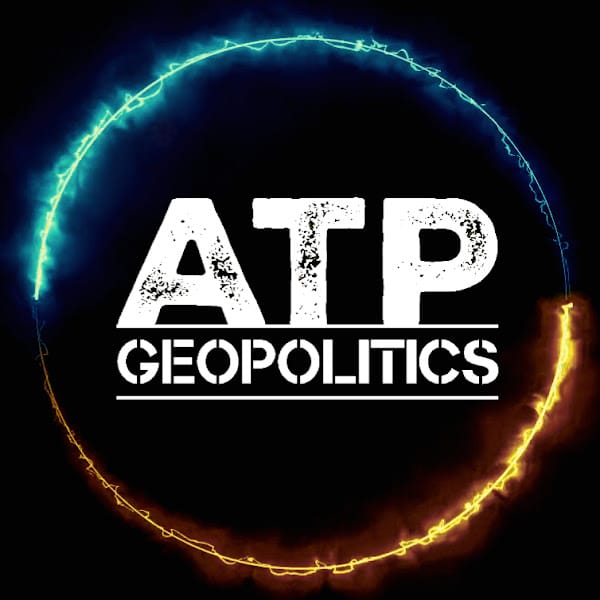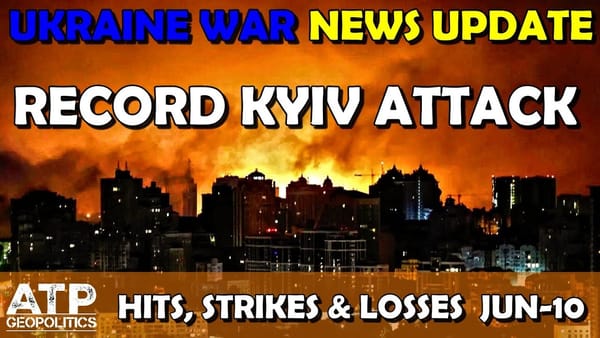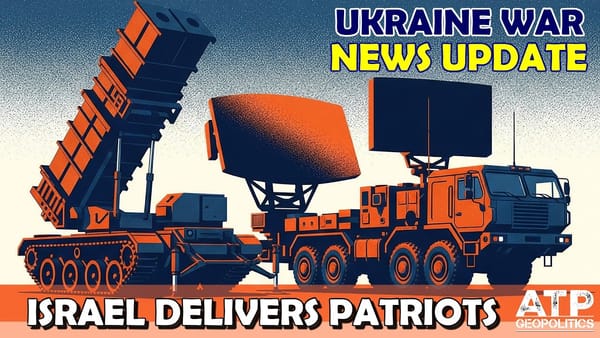Ukraine War Update: Kursk Attack News & Analysis
Table of Contents 📖
"Honestly, I don't care anymore what flag we're under as long as it's peaceful. Wow, that's a real admission there. If our own can't protect us, so law enforcement, the soldiers, maybe at least Ukrainians can. Bye, he says. Wow, wow wow i know that's just anecdotal but wow"
Hello Team
🎦 00:00-00:31⏩
Jonathan welcomes viewers to another video update from ATP Geopolitics about the war in Ukraine with news and analysis on the Kursk offensive. The map used in the video is from Andrew Perpetua at MilitaryLand.net.
Return to top⤴️
Front Line Update: Kursk
🎦 00:31-03:23⏩
Jonathan discusses recent Ukrainian gains in the Kursk region of Russia. He notes that Ukrainian forces have made more progress there than in the direction of Prokrosk, with the salient being larger in Kursk. He highlights claims that both sides are pulling troops from other areas to support their respective offensives and defenses in Kursk.
Return to top⤴️
Gerasimov Replaced
🎦 03:23-11:32⏩
Jonathan reports that General Valery Gerasimov, Russia's top military commander, has been replaced by FSB chief, Aleksandr Bortnikov, in overseeing the Kursk operation. Jonathan gives a summary of Gerasimov's public appearances since reports of him being wounded in a strike in Crimea. Jonathan notes that Gerasimov's prolonged absence from public view, especially as the head of the war effort, suggests that he may be suffering from health issues or injuries. This theory is supported by the fact that Gerasimov has been increasingly sidelined, with his responsibilities being gradually transferred to others. Jonathan observes that the Kremlin has designated the Kursk region and surrounding areas as part of a "counter-terrorist operation" (CTO). This designation allows for the replacement of Gerasimov with Bortnikov, who has experience in counter-terrorism. Jonathan suggests that this is a way for Putin to subtly sideline Gerasimov without directly acknowledging any issues with his performance or health. Jonathan then cites reports suggesting that Putin may have been dissatisfied with Gerasimov's handling of the situation in Kursk, particularly his failure to anticipate the Ukrainian offensive despite intelligence warnings. He mentions reports from Bloomberg stating that Russian intelligence had information about Ukraine's plans to breach the border in Kursk two weeks in advance but Gerasimov chose not to inform Putin. Jonathan questions how much Putin actually knows about the realities on the ground, given his limited access to information and his reliance on a curated information bubble controlled by individuals like Gerasimov. Jonathan shares insights from the Institute for the Study of War (ISW) which supports the notion that Putin was unhappy with the military's response in Kursk. He highlights an article from The Daily Wrap that suggests Bortnikov's appointment is due to his past success in managing crises that threatened Russia's domestic stability and the Kremlin's regime. Jonathan examines claims from various sources, including The Daily Wrap, Beef Eater, and Guardian of Facts, which indicate that the "counter-terrorism" label might be a facade to facilitate Bortnikov's appointment and sideline Gerasimov. The sources suggest that Bortnikov is seen by some in the Kremlin as Putin's potential successor. Jonathan notes Bortnikov's controversial past, including his alleged involvement in the poisoning of Alexander Litvinenko in London in 2006 and his ambition to reinstate a Soviet-style order within the special services.
Return to top⤴️
Economist: Troop Transfers
🎦 11:32-12:50⏩
Jonathan reports that The Economist has published information, based on a Ukrainian General Staff source, stating that Russia is redeploying troops from the Kharkiv and Donbas regions to Kursk. This contradicts earlier reports, mentioned by Jonathan in a previous video, where a Ukrainian commander said they hadn't seen evidence of significant Russian troop movements away from the eastern front line. Despite this, Jonathan suggests that it's likely the Russians are redeploying troops from the east, although perhaps not as quickly as they would prefer due to logistical challenges. The source quoted in The Economist states: "Their commanders are not idiots, they are moving forces, but not as fast as they would like. They know we can't stretch logistics 80 or 100 kilometers." The article also mentions that Ukrainian forces have managed to penetrate up to 40 kilometers into the Kursk region.
Return to top⤴️
Mick Ryan: Kursk Offensive Analysis
🎦 12:50-18:49⏩
Jonathan shifts focus to the analysis of retired Australian General Mick Ryan on the Kursk offensive, who outlines three potential options for Ukraine as the offensive progresses:
- Option 1: Consolidate and Defend: This involves Ukraine securing the territory it has already gained and defending it. Ryan considers this the riskiest option due to the vulnerability of the multiple, small salients Ukrainian forces currently hold, which could be easily cut off and destroyed by the Russians. He highlights the risk of heavy losses, including battalions, brigades, artillery, electronic warfare, and air defence systems. Ryan argues that while this option aims to maintain pressure on Russian sovereignty and tie down their forces, the potential losses and the negative impact on Ukraine's strategic messaging (undermining the success of the surprise attack) outweigh the benefits.
- Option 2: Partial Withdrawal: Ryan suggests that Ukraine could withdraw from some of the captured territory to more defensible positions. This would lower the risk of losing troops and resources compared to Option 1, allowing for the redeployment of troops to other areas as needed, such as the Donbas or for future cross-border operations. He acknowledges that this would require significant engineering efforts to fortify the new defensive lines with minefields, trenches, and bunkers, as well as to establish robust logistics. The objective here would be to continue applying pressure on Russia, forcing them to keep troops in the area, and potentially using it as leverage in future negotiations. He believes that the potential gains, including the humiliation of Putin and the Russian military, might outweigh the risks involved.
- Option 3: Full Withdrawal: This entails Ukrainian forces withdrawing entirely back to the international border. Ryan posits that this would enable Ukraine to capitalize on the political and strategic impact of the offensive while preserving experienced combat troops for future offensives. He suggests that this option would send a strong message to Russia, demonstrating Ukraine's capacity to invade but also their lack of interest in occupying Russian territory. This would portray Putin as weak, having been unable to retaliate effectively for the incursion. The objective, according to Ryan, would be to undermine Putin, conserve Ukrainian forces, and demonstrate to international allies their ability to conduct offensive operations effectively. He believes this option offers Zelensky the best chance for domestic political gain and a boost to Ukrainian morale.
Jonathan then provides his own analysis, emphasizing that Ukraine's primary objective in the war is to reclaim its lost territory. He argues that Ukraine might be willing to engage in actions that might result in temporary territorial losses if it serves the broader goal of eventually reclaiming all its territory. Jonathan underscores the importance of minimizing troop casualties as a key metric of success for Ukraine, unlike Russia, which seems willing to accept much higher losses. He suggests that Ukraine will carefully weigh the potential for casualties in Kursk against the benefits of holding the territory. Jonathan speculates that a full withdrawal, potentially after disrupting Russian logistics in the area, might be the most advantageous option for Ukraine, allowing them to redeploy their forces for use elsewhere, including integrating and training new units. Jonathan concludes by highlighting the factors that will influence Ukraine's decision, including Russian actions in Donbas, the response in Kursk, domestic and international political considerations, and the sustainability of the operation.
Return to top⤴️
Emil Kastelahimn: Kursk Offensive Analysis
🎦 20:10-28:08⏩
Jonathan moves on to Finnish analyst, Emil Kastelahimn's assessment of the Kursk offensive, who describes it as a "medium-risk, medium-reward operation". He notes that after a week of fighting, neither Koronevo nor Sudja are fully under Ukrainian control and that Russia has likely blocked further advances in the north. He questions whether there are "massive game-changing objectives" for Ukraine to achieve in the region, but adds that a catastrophe is also unlikely. Jonathan suggests that the Ukrainians are likely to be solidifying their gains or may even be considering a withdrawal to more defensible positions, as suggested by Mick Ryan. He cites reports that Russian counterattacks have pushed Ukrainian forces out of the village of Martinovka, although other reports claim it has been retaken. He mentions uncertainties around the control of Koronevo, with No Reports (OSInt Twitter account) reporting a Ukrainian presence to the east of the town, suggesting that they may be attempting to flank it. Kastelahimn acknowledges that while Ukraine hasn't made significant progress in recent days, they have held onto most of the territory they have gained. He believes that Russia's efforts to regain control are proving difficult due to the Ukrainian's ability to maintain the initiative. However, he cautions that as more Russian reinforcements arrive, achieving operational success will become more challenging for Ukraine. He also notes that committing more troops to Kursk would increase the risk for Ukraine, especially given the challenging situation in eastern Ukraine. Jonathan then discusses Kastelahimn's view on the potential outcomes if Ukraine were to commit more resources to Kursk. He notes that while securing more territory would strengthen Ukraine's position in future peace negotiations, maintaining control of that land would be a challenge. Jonathan then proposes a scenario where Russia might allow Ukraine to keep the territory they've taken in Kursk, effectively freezing the front, under the assumption that they can regain it in future negotiations. He suggests that Russia might prioritize its efforts in eastern Ukraine, where it can potentially make more significant gains, over Kursk. Jonathan concludes by summarizing Kastelahimn's assessment, stating that the Kursk offensive is turning into a "medium risk, medium reward operation" without any decisive objectives for Ukraine. Kastelahimn believes that Ukraine's best course of action would be to target Russian reinforcements heading to Kursk with HIMARS and air strikes, potentially creating opportunities for Ukraine to make gains in the east.
Return to top⤴️
Looting in Kursk
🎦 28:08-30:40⏩
Jonathan highlights reports of widespread looting in Russian-held areas of Kursk, claiming that it's being carried out by Russians themselves, not by Ukrainian forces. He cites a Twitter thread by ChrisO_wiki, which references a Telegram channel that has been documenting the deteriorating situation in the region. The reports indicate a complete breakdown of law and order, with police, firefighters, doctors, and administrative officials absent from the areas affected by the fighting. It's estimated that over 76,000 people have fled these areas, many without organized evacuation support, leaving behind mostly elderly residents. The Telegram channel attributes the "rampant looting" to the Russians themselves, although it remains unclear whether this is being done by opportunistic civilians or by undisciplined soldiers. The reports paint a picture of chaos and desperation, with residents feeling abandoned and forced to fend for themselves.
Return to top⤴️
Account from Russian man in Sudia
🎦 30:40-31:54⏩
Jonathan shares the account of a Russian man from Sudia in Kursk, who describes encountering Ukrainian forces and witnessing the Ukrainian flag flying over the city administration building. He says that he saw many Ukrainian soldiers and military equipment, and he was stopped by a soldier while trying to take a photo. The soldier, who he described as being polite, checked his documents and informed him that filming was not allowed. When asked what was going to happen, the Ukrainian soldier reportedly told him to "learn Ukrainian" and "prepare for a referendum". The man ends his account by expressing his shock at the situation and his indifference to which flag flies over him as long as there is peace. He adds "If our own can't protect us, maybe at least Ukrainians can."
Return to top⤴️
Tender/Smiley: Ukrainian Advance/False Flag Warning
🎦 31:54-33:25⏩
Jonathan provides an update on the situation in Kursk, noting that Tendar (OSINT researcher and mapper) has retracted earlier reports of Ukrainian forces being further east than previously thought. This was based on sightings of a Ukrainian BTR-4, which was initially thought to have been captured by the Russians. Jonathan then shares a warning from Eastern European expert, Sergei Sumlenny, who cautions that the FSB might stage false flag operations by executing local Russians while dressed in Ukrainian uniforms to discredit Ukraine and undermine support for them. He draws parallels with similar tactics employed by the NKVD, MGB, and KGB in the past.
Return to top⤴️
Ukrainian Su-27s in Kursk Airspace
🎦 33:25-35:10⏩
Jonathan reports sightings of Ukrainian Su-27 fighter jets operating within Kursk airspace, suggesting that Ukraine may have gained air superiority in the region. He speculates that the Su-27s are likely being used for close air support missions. He concludes by sharing an update from No Reports, who claims that the town of Tytinka is now under full Ukrainian control, although Russian forces are pushing back from the east.
Return to top⤴️
Wrap up
🎦 35:10-35:13⏩
Jonathan signs off, thanking viewers for their support.
Return to top⤴️




